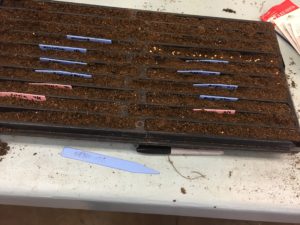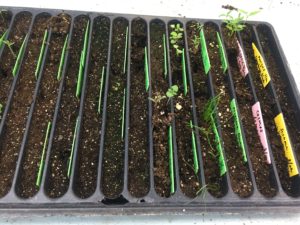With September here, Autumn is round the corner. This is a great time to plant a tree. I would like to suggest it as an activity for grandparents to do with their grandchildren – not just because of Grandparents day. There is nothing like the planting of tree that speaks of a grandparent’s optimism for the future. You are doing something, the full result of which you may not see. A tree may take 40 years to reach its full glory. Or plant one with your children or as a memorial to someone who passed away this year. There is nothing better you can do for the environment – trees provide shade thus helping to keep the house cool. Trees take in carbon dioxide which is good for the environment. Trees are fun things for children and grandchildren to climb on or swing from. Trees provide flowers in spring, fruit for us and for the birds and nuts for those pesky squirrels.
I live in a park-like setting – on over two acres, generously sprinkled with trees. Some I have planted, others I inherited. My recommendations come from living in this setting for 25 years. Central Illinois is not the easiest place to live in –for us or for the trees. Snowstorms, ice storms, tornadoes, heat, humidity, hot, dry spells and flooding are all things to expect. So it is only natural and necessary to first consider which trees have withstood these conditions the best – after all you are planting something that you hope will live for decades.
On the south side, many trees have not survived; others have struggled. The ornamental pear got knocked down one spring in 2001. The tree became fire wood – but something came back from the ground. Two saplings emerged. I did not cut any of them so they grow as one tree. This may be in their best interest because we all know the tendency to split open. In this setting right now, as each has its own trunk, perhaps it will survive. The Buckeye gets pretty, white flowers every spring but ever since the advent of Japanese beetles in the past five years, by August, the tree has been stripped. The sugar maple which I had planted, I later learned it does not like a southern exposure. The top leaves are scorched, but it does provide welcome shade to the sunroom. The cork willow is a great addition with its whimsical, crooked wavy branches, which are very sought-after for flower arrangements but it has a huge gaping hole in it. The silver maple is huge and offers great shade, but everybody knows its disadvantages – shallow roots which get into the way of the mower and its tendency to drop branches.
Among fruit bearing trees, the Peach tree died some 23 years ago. We enjoyed the peaches for just two seasons. A sour cherry tree gets the sunscald and is not looking pretty. Its companion is already history. A bing cherry tree planted on the northeast, lived a few years but did not survive the 9 inches of rain we received last June. Two apple trees have not survived – I was told they are not expected to last more than 20-30 years. Among recent additions of dwarf apple and pear trees planted – three and two of them respectively – the winner is yellow delicious apple – the much touted Honey crisp gets consumed by Japanese beetles.
For the newer additions to the garden, I planted a Linden tree a few years ago, but gave up when the Japanese beetles came to town. I even covered the young tree up one season with bridal netting! In its place, I planted a Magnolia Butterflies over a year ago. I was anxiously waiting for the pretty yellow flowers – instead the ice storm that destroyed so many trees last winter knocked off several branches– though it did leave a few. The next few years will tell if it can survive in this setting.
Finally the Ash trees – what can I say about them? Two beautiful specimens provided welcome shade to the deck. One large branch of one did break off a few winters ago. But it seemed to be doing well last season. After this winter, one look at it was enough to confirm the worst – the emerald ash borer has taken over – they will both be history soon.
Other sides of the house the trees fare a little better – although the Austrian pines have not survived nor the Serbian spruce. So given this history, what are my recommendations?
First, for an understory trees there is not better choice than a Redbud. An understory tree is one that grows in the shade of larger trees. The one we have was literally a twig handed out one Arbor Day at the Forest Park Nature Center – to my son. Being 10 years old and an optimist and energetic, he and his friend dug the hole, dragged over a bag of good soil and planted it. Now over a decade later, every spring we can enjoy its beautiful pink flowers and the heart-shaped leaves that follow.
For smaller spring flowering trees another winner is Crabapple Prairie fire. Having had to look at the two prominently displayed specimens in the yard opposite and seeing how dreadful they looked by late summer – I was very cautious, but have been won over by Prairie fire. It still has leaves in fall, berries that the birds love, and pretty spring flowers.
Sweet Gum. This tree also had an unfortunate first few years- a summer drought when I was away and the main leader all dried up. But I let one of the adventitious buds grow and now the 20 foot tree- which is columnar, has neat star-shaped leaves all season and gorgeous fall color well worth the wait. I have not encountered any annoying fruits, which I was warned about. I suspect I was able to get one of the non-fruiting varieties, which are available.
Honey Locust Skyline. This I planted by myself and is easily by best success. The thorn less varieties now available have no problems- no known pests. They provide good green leaves in spring offering dappled shade, and pretty yellow fall color. The leaves are so small they do not need raking.
In our area, maples and oaks are favorites and considered safe options. In our town of Washington, a recent post-tornado tree inventory found 30 percent of the trees on common areas were maples –so we like to suggest other alternatives to people. Incidently, the one tree I notice that survived the tornado amount the newly planted trees were the beeches – their ability to bend perhaps.
Among evergreens, few are able to withstand the weather conditions here. One good choice is a Colorado Blue Spruce Fat Albert is a good choice. The needles are pretty blue color and the tree does not grow too tall. It did bend over during our last ice storm but was straightened right back.
Finally another surprising winner in my park-like garden – the Walnut tree. Common in older yards one rarely finds them in nurseries. The positive aspects are the angle – the crotch between the stem and the branch – almost providing a 90 degree angle helps it withstand storms, rain and ice storms. I have two of them – they grow slowly but are gradually providing delightful shade. I was told that the roots give out juglone, a poison for other plants but have not found that a problem. I have successfully grown both hostas and irises under them. There are several plants that do well under them. The leaves start turning yellow in late summer itself and are small enough that they do not need raking. How about those walnuts? Well the squirrels enjoy them, and anything that can keep them away from the birdfeeders is a plus!
Just do not let this fall go by without planting a tree. Then, as you sit back and enjoy the beautiful spectacle of the falling leaves this autumn – the yellows and purples, tawny oranges and browns, you can feel good that you have done something – be it a small something to help this planet we call our home. Happy Gardening!
Read More

